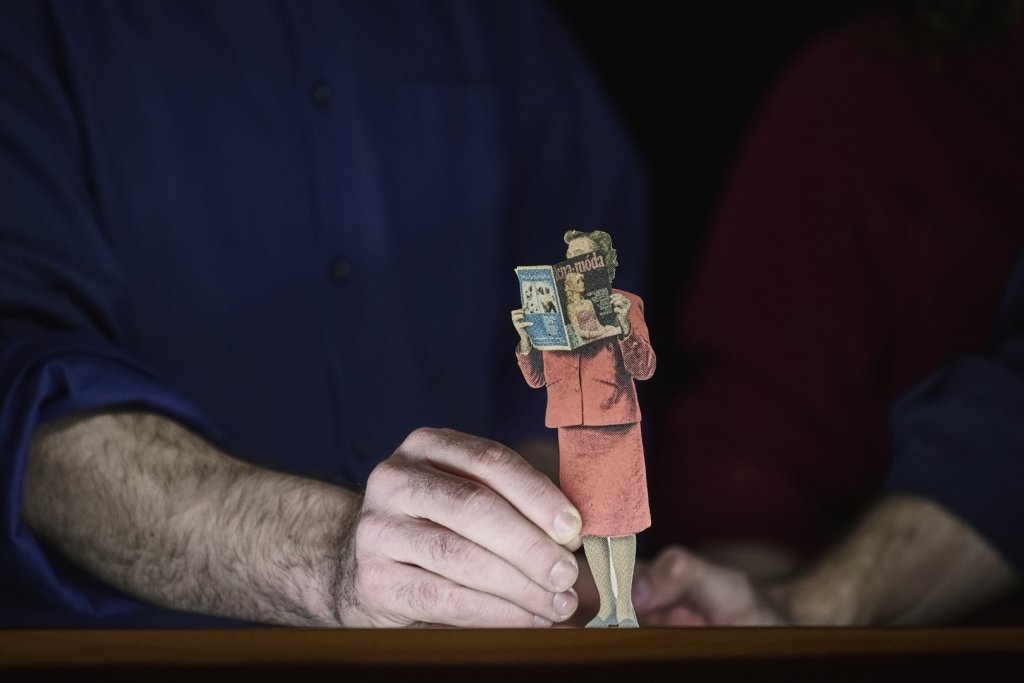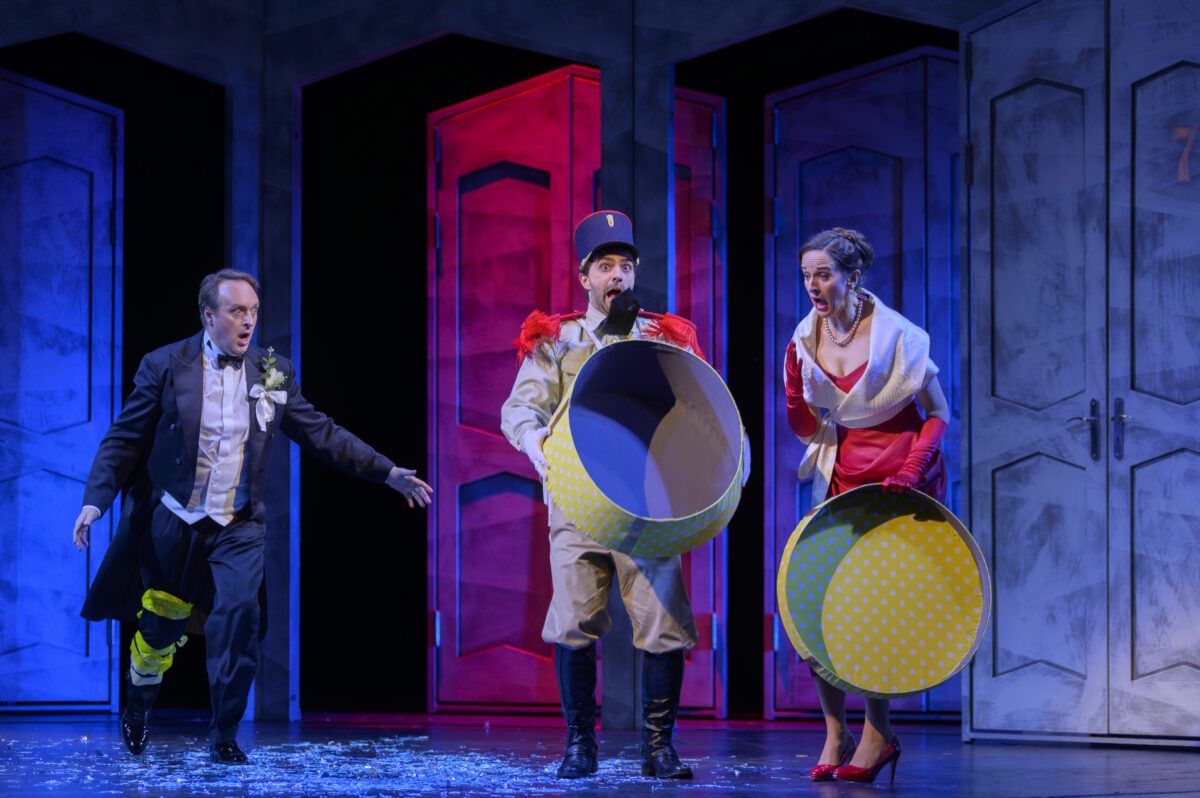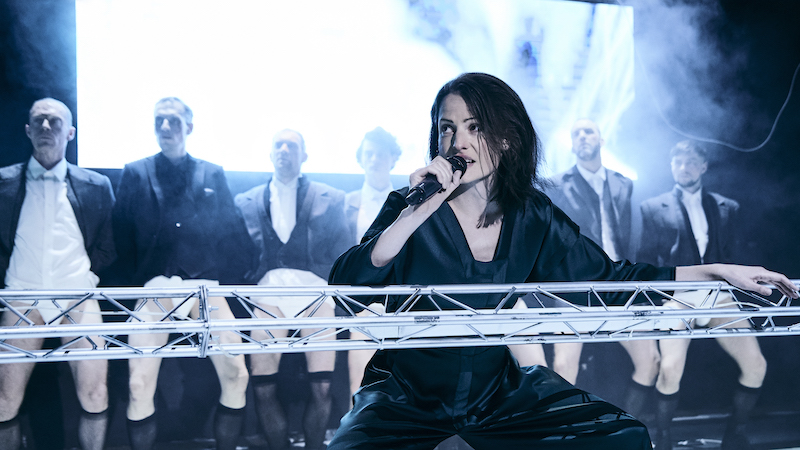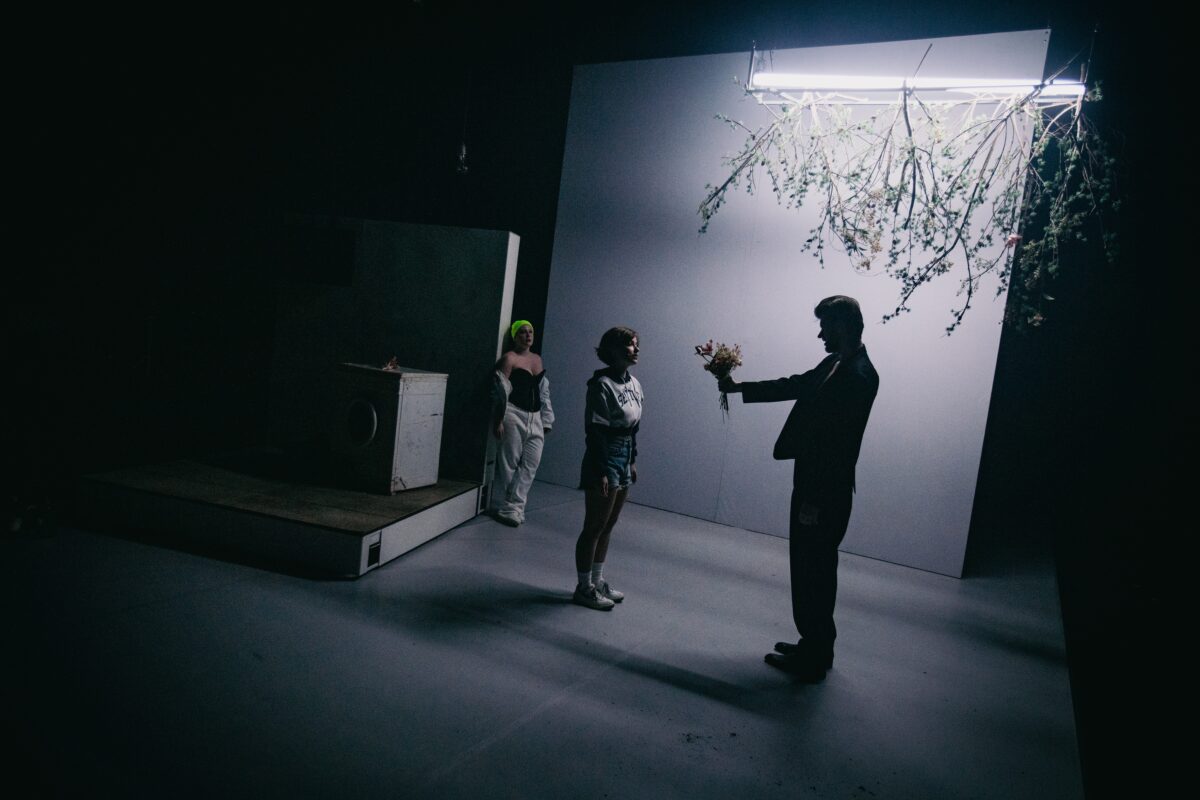Zuzana Augustová
The work of Franz Kafka is part of what is known as “Prague German literature,” which can be classified as Expressionism, but contains elements of Surrealism and motifs of absurdity. His prose, in particular, has such a timelessly absurd tone that he has inspired artists working in literature, theatre, cinema and the visual arts for the whole of the 20th century and the beginning of the 21st.
Kafka himself wrote only one dramatic fragment in late 1916 and early 1917, which was published by Max Brod and titled Der Gruftwächter (Strážce hrobky in Czech, The Warden of the Tomb in English). It was published in 1936 but was released in a Czech translation by Jiří Stromšík only in 2003.[1] The play was first staged by Jean-Marie Serreau in 1950 at Poche Montparnasse in Paris. The German premiere, directed by Rudolf Jürgen Bartsche, took place on 7 November 1950 at the Zimmerspiele Mainz / Haus am Dom. In 1965, it was filmed by the Belgian director Harry Kümel. A radio play, directed by Ferry Baurer, was presented by Austrian Radio on 21 October 1969. It has yet to be presented in the Czech Republic.
The fragment The Warden of the Tomb can be considered as part of the metaphysical strand of Expressionist literature, of which Kafka was a leading representative. From the narrative character of the Warden, we learn of apparitions from beyond the grave: each night, the Warden grapples with the dead, who try to escape the prince’s park. In German, but also in Czech Expressionist drama, the motif of communication between the living and ghosts occurs relatively often. In Czech drama, not even this strand of Expressionism is without humour, as seen in the plays Před nebeskou branou (Before the Heavenly Gate, 1922) by Lev Blatný, Matěj Poctivý (Honest Matěj, 1922) by Arnošt Dvořák and Ladislav Klíma (1922) and Mrtvá (The Dead, 1919) by Arnošt Dvořák . In contrast, similar German Expressionist texts are characterised by a dark, spectral atmosphere. Kafka’s text, however, lacks both spectrality and humour, even though he is said to have laughed when reading his works to a circle of friends. Nor do we find in it any elements of heroism, as in Franz Werfel’s debut work Besuch aus dem Elysium (The Visit From Elysium, 1910).
All of the direct and narratively processed action and interactions between the characters, like their reciprocal relationships, are subject to the logic of dreams. Dream logic generally determines the shape of Kafka’s fictional world, the structure of the characters’ statements and the way in which he constructs the story. Even though individual details of Kafka’s literary world border on hyperrealistic, they are placed in an entirely unreal context. Thanks to the specificity of details and the objectification of the characters’ subjective states, Kafka achieves a seemingly matter-of-fact and austere style. In this, his texts diverge from the straightforward, rhetorical Expressionism as represented by the Prague German-Jewish writer Paul Kornfeld in his first dramatic work Der Verführung (Svedení in Czech, The Seduction in English, 1916).
Expressionism disrupts the real dimension of time-space and the progression of events. Duke Friedrich has been appearing to the Warden of the Tomb for thirty years, even though he has only been dead for half that time. The Warden projects his own feelings onto the other characters, as is typical of the subjective perspective of Expressionist drama. He shows tender paternal affection towards the prince, even though he is encountering him for the first time. The immediate mutual closeness of the characters evokes Karl Rossmann’s encounter with a stoker on his father’s ship in the short story Der Heizer (Topič / The Stoker, 1913), later inserted into the novel Amerika, originally titled Der Verschollene (Nezvěstný / The Man Who Disappeared, published 1927). In both The Warden of the Tomb and The Stoker, the sudden bond between the two protagonists has the deep intimacy and existential dimension that we know from dreams. Dream logic and a subjective perspective are also associated with August Strindberg’s pre-Expressionist plays To Damascus (1898) and A Dream Play (1902), which became models for Expressionist authors.
The dominant feature of Kafka’s dramatic world, however, remains the metaphysical perspective itself, which cannot be identified with the characters or the authorial subject. At the same time, Kafka’s work cannot simply be placed in the “O – Mensch – Dichtung” line, i.e. read as a messianic-activist drama linked to a vision of the New Man and the just ordering of society, not only in the material sense, but, above all, in terms of the liberation of the spirit. At the time, Expressionist utopias complemented apocalyptic visions of the destruction of the old world. Landmark German plays of this type include Ernst Toller’s Die Wandlung (Transfiguration, 1919) and Georg Kaiser’s Gas (1918) and Gas II (1920). Their protagonists represented the New Man, who will have no more need of God, because he brings salvation himself. Some works by Kafka’s friend Max Brod are part of this line. In the play Die Retterin (Zachránkyně, published 1914) and the one-act play Erlöserin (Vykupitelka, 1921), he created a positive, Marian prototype, albeit paradoxically depicted by saleswomen. In Paul Kornfeld’s work, this is represented by the lesbian prostitute Marie from the play Himmel und Hölle (Heaven and Hell, 1919). Characters of self-sacrificing, “holy” maids also frequently appear in the prose of Franz Werfel, in which they address problems of Christianity, faith and salvation.
In the novel Nicht der Mörder, der Ermordete ist schuldig (Not the Murderer, but the Victim Is Guilty, 1919), Werfel dealt with central Expressionist general conflict between sons and fathers, representatives of the old, bourgeoisie world of stale, ossified values against which the sons are fighting. The conflict with patriarchal authority is also central in a number of Kafka’s texts, starting with Brief an den Vater (Dopisem otci / Letter to His Father, 1919) and the breakthrough short stories Die Verwandlung (Proměna / The Metamorphosis, 1912) and Das Urteil (Ortel / The Judgement, 1912), in which the father represents a kind of higher divine authority whose power includes pronouncing a death sentence on the son, which the son immediately carries out himself by jumping into the river. In The Metamorphosis and The Judgement, but also in Amerika, The Trial and The Castle, we also find the frequent Expressionist motif of the protagonist’s loneliness in an unfriendly world and exclusion from human society, which Werfel’s, Kornfeld’s and Toller’s protagonists also encounter: “A deep belief in their own inadequacy emerges as a constant theme in all Expressionist works. Indeed, Expressionism can be seen as an entire generation’s attempt to come to terms with the sense of devastating self-loathing to which modern poets are subject.”[2] The autobiographical characters in these plays hate the bourgeoisie and despise their greed and pursuit of success, even as they envy their lives. They find themselves forever on the periphery of society, or are excluded from it in advance due to some fateful trait, even though they wish to be at the centre of societal events. As Walter Herbert Sokel writes, “Something within them prevents them from […] being able to partake of the world’s warmth and love.”[3]
Nevertheless, it can be said that Kafka’s work is unlike anything in the literature of his time. Kafka’s “texts […] circle around some unspecifiable absolute value, we could call it an absolute truth,” writes Ingeborg Fialová-Fürstová. In this absolute value in Kafka’s texts, combined with his critique of modern rationalism, I see a parallel with the beliefs of the Austrian philosopher Ludwig Wittgenstein: “[…] even when all possible scientific questions have been answered, the problems of life remain completely untouched.”[4] Among Czech authors, Jan Patočka comes close to this dimension of Kafka’s work in the volume Negativní platonismus (Negative Platonism, written in the early 1950s, but published only in 1990), with the thesis of the negative, non-substantial idea as a concentration of inaccessible meaning. Fialová-Fürstová continues: “It is typical of Kafka’s texts that this value is never in any way concretised in them: in the parable Vor dem Gesetz (Before the Law), it is expressed as […] an inextinguishable blaze that breaks through the doors of the Law … this absolute value – very indeterminate and ungraspable, but nevertheless existent in the text, in metaphor – rebels against closer contact and examination […] Kafka thus defines the human negatively, as a being whose curse is to reach […] the highest values, however indeterminate […] and these highest values, then […] are depicted as existent but manifested only by their unattainability.”[5] In the motif of the unattainability of the highest value, there can then be found a similarity to the assertion, by 20th-century French mystic Simone Weil, of the total absence of God in this world.[6]
During the communist regime, Kafka only began to be published and performed in Czechoslovakia to a limited degree in the 1960s, after the international literary studies conference, “Franz Kafka”, organised in Liblice in 1963, largely thanks to the Germanist Eduard Goldstücker and intended to erase the taboo status of Kafka’s work in the Czech cultural context. Shortly thereafter, director Jan Grossman dealt with Kafka’s work, both theoretically[7] and practically, as a theatre maker. In 1966, he dramatised The Trial and presented it at Prague’s Theatre on the Balustrade. Grossman highlighted Kafka’s proximity to absurdist theatres: “For Grossman, the absurdity was a further prerequisite for [Kafka’s] theatricality”, writes Tereza Pavelková, continuing, “[Kafka] managed in his […] works to depict a world markedly similar to our real one, but which also seems unnatural and deformed.”[8]
Another wave of dramatisations and productions of Kafka appeared in the mid-to-late 1980s and early 1990s. At the end of totalitarianism, productions of Kafka were both an expression of the disintegration of the regime and a means of criticising it. The first such production was Amerika, directed by Petr Osolsobě and Jan Antonín Pitínský at Ochotnický kroužek (The Amateur Circle) in 1985. In 1988, Petr Lébl and his ensemble JELO presented their own dramatisation of a Kafka story in Prague, titled Přeměna – wie hatte sich die Schwester denn so schnell angezogen? (The Metamorphosis – How Did the Sister Get Dressed So Quickly?). Here, the “main shift was a clear strengthening of the metaphor of a totalitarian regime. Lébl set Kafka’s story in the context of Czech-German relations… he focused mainly on the motifs in Czech-German relations of the time, which were linked to totalitarianism (i.e. the Nazi occupation) and also used multiple references to the socialist ideology, which quickly supplanted the Nazi occupation.”[9] In early 1989, Studio Ypsilon presented Amerika, dramatised by Zdeněk Hořínek and directed by Jan Schmid. In 1994, not long after the Velvet Revolution and in new socio-political conditions, a film of the same name, based on the production, was made by director Vladimír Michálek.
In the spring of 1989, a production of Proces (The Trial), dramatised and directed by Arnošt Goldflam, premiered in the Brno studio theatre HaDivadlo, which had staged productions strongly critical of the communist regime throughout the normalisation era thanks to poetic stage metaphors. At the centre of Goldflam’s adaptation “stood not Josef K., but the court process itself […] An Expressionist vision of the work from the position of the subject […] changes in the production into a concrete stage reality of an absurd, totalitarian work, in which everyone is part of a constant, ceaseless court proceeding.”[10]
After the fall of the communist regime, the Kafka repertoire “appeared in the work of Czech theatres and in productions by the English language ensemble Black Box, which presented dramatisations of the story The Metamorphosis[11] and the novel The Trial,[12] or as part of the festival Kafkovy divadlení dny (Kafka Theatre Days), organised in 1992 by the Franz Kafka Society.”[13] After the year 2000, two further waves of Kafka productions appeared, perhaps linked to the feelings of threat, uncertainty and the absurdity of our world, along with its institutions and rules. Theatre makers again reached for the three best-known prose works: after 2000, The Metamorphosis was staged four more times,[14] Amerika three times[15] and The Trial was staged eight times[16] following the HaDivadlo production. The works of Franz Kafka resonate even in contemporary Czech theatre. This is evidenced by the fact that, in the 2023 and 2024 seasons alone, we can find nine titles based on his literary works in the repertoires of theatre and dance ensembles across the Czech Republic.
[1] Franz Kafka: Povídky II, Prague: Nakladatelství Franze Kafky, 2003. This dramatic fragment is also part of the anthology Expresionistické drama z českých zemí. A clean copy and two expanded fragments of Kafka’s texts, including passages that the author struck out (here, in contrast to the original, the character of the Princess appears at the end), were included in the selection of Czech plays and plays translated into Czech from German (all other German texts were translated for the first time for the anthology). See Zuzana Augustová, Lenka Jungmannová, Aleš Merenus, eds.: Expresionistické drama z českých zemí, Prague: Academia – Ústav pro českou literaturu, 2020.
[2] Walter Herbert Sokel: Der literarische Expressionismus, Munich – Vienna: Albert Langen – Georg Müller, 1970, p. 107.
[3] Ibid.
[4] Ludwig Wittgenstein: Tractatus logico-philosophicus, trans. D. F. Pears and B. F. McGuinness, London: Routledge, 2001, p. 88.
[5] Ingeborg Fialová-Fürstová: Expresionismus, Olomouc: Votobia, 2000, p. 181-182.
[6] Simone Weil: Dobro, mez a rovnováha, Prague: Mladá fronta, 1996.
[7] See Jan Grossman. Kafkova divadelnost? In: Jan Grossman, Terezie Pokorná, Jiří Holý: Analýzy, Prague: Československý spisovatel, 1991, p. 332.
[8] Tereza Pavelková: Inscenace díla Franze Kafky režisérské generace přelomu 80. a 90. let v širším kontextu alternativní kultury, master’s thesis, Department of Theory and Criticism, Theatre Faculty of the Academy of Performing Arts in Prague (DAMU), 2017, p. 91-92.
[9] Ibid., p. 108.
[10] Ibid., p. 97.
[11] Franz Kafka – Steven Berkoff: The Metamorphosis, direction: Nancy Bishop, Black Box, Prague, premiere 24.6.1997, Theatre in Celetná Street, Prague.
[12] Franz Kafka – Gwen Orel: The Trial, direction: Nancy Bishop, Black Box, Prague, premiere 16.6.1999, Skelet Theatre, Prague.
[13] Martina Pecková Černá: “Podmínky pro rozvoj českého nezávislého divadla 90. let 20. století.” In: Martina Pecková Černá, ed. Divadlo a svoboda, Prague: Institut umění – Divadelní ústav, 2021, p. 115.
[14] Theatre a 7 and a Half, Brno (2002), Prague Chamber Theatre at Komedie Theatre (2003), Švanda Theatre, Prague (2014), Studio Ypsilon, Prague (2015).
[15] The J. K. Tyl Theatre, Pilsen (2014), Goose on a String Theatre, Brno (2018), D21 Theatre, Prague (2021).
[16] The F. X. Šalda State Theatre, Liberec (1990), Zlín City Theatre (1997), The Drama Club, Prague (2001), the Petr Bezruč Theatre, Ostrava (2002), Prague Chamber Theatre at Komedie Theatre (2007), Aréna Chamber Stage, Ostrava (2011), Roxy/NoD, Prague (2014), Polárka Theatre, Brno (2021), Petr Bezruč Theatre, Ostrava (2023).
categories
Drama

 Learn
Learn








